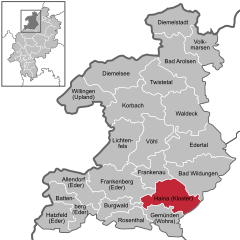Geography
Location
Haina lies in Waldeck-Frankenberg south of Frankenberg and east of Burgwald at the southwest slope of the Kellerwald range. It lies on the river Wohra not far west of the Hohes Lohr (the Kellerwald range's second highest peak at 657 m).
Constituent communities
Haina consists of the following 12 centres: Altenhaina, Battenhausen, Bockendorf, Dodenhausen, Haddenberg, Haina (administrative seat), Halgehausen, Hüttenrode, Löhlbach, Mohnhausen, Oberholzhausen and Römershausen.
History
The former Cistercian monastery in Haina is Hesse's most important Gothic building works. Haina Monastery was built by monks from the Altenberg Monastery in the Bergisches Land . In 1188, they had moved to the Aulesburg (castle) near Löhlbach, and thirty years later they moved again, this time to Haina.
Through donations, buying and exchanges, the Haina Cistercians earned themselves a rich estate, from the Weser all the way to the Main. In 1527, the monastery was shut down by Philip I, Landgrave of Hesse – known as Philip the Magnanimous – and turned into a state hospital.
The Monastery Church, built between 1215 and 1330, is the earliest Gothic building in Germany. The former monastery nowadays houses a psychiatric hospital.
In 1789, the Abbot of the Haina Monastery Friedrich von Stamford built the Stamfordscher Garten in Haina, creating the landscaped style of an "English garden".
This page is based on this
Wikipedia article Text is available under the
CC BY-SA 4.0 license; additional terms may apply.
Images, videos and audio are available under their respective licenses.












